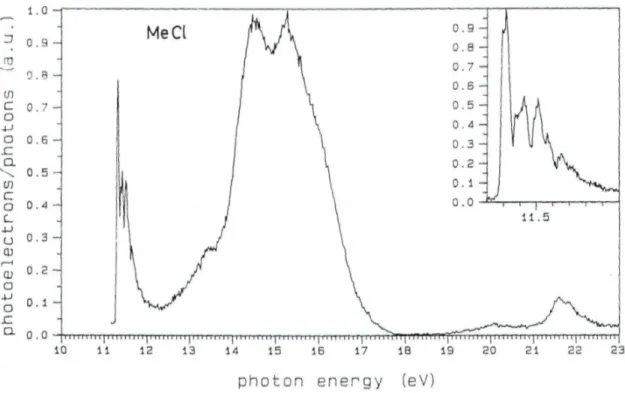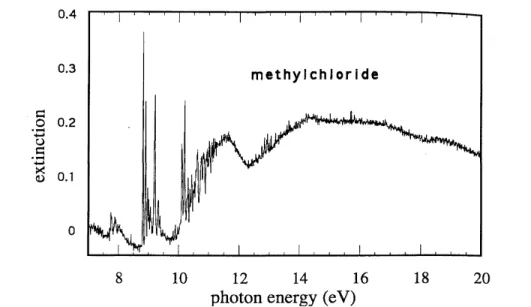Published in: (1996), pp. 162-164 Status: Postprint (Author’s version)
THE THRESHOLD PHOTOELECTRON, CIS- AND
PHOTOABSORTION SPECTRA OF THE METHYL MONOHALIDES
(Cl, Br AND I).
R. Locht, B. Leyh1,
Département de Chimie Générale et de Chimie Physique, Université de Liège, Institut de Chimie, Bat. B6, Sart-Tilman par B-4000 Liège 1, Belgium.
H.-W. Jochims, K. Hottmann and H. Baumgärtel.
Institut für Physikalische und Theoretische Chemie, Freie Universität Berlin, Takustrasse 3, 14195 Berlin, Germany.
In several previous papers we reported on the electroionization, photoionization and dissociation of methyl fluoride (CH3F) [1,2]. Threshold photoelectron spectroscopy and threshold photoelectron-photoion coincidence spectroscopy of this molecule have also been performed [3]. More recently, a surprisal analysis of the translational energy distribution of CH3+ from CH3F has been reported [4]. Rydberg series lying in the 18-20 eV energy range were shown to play an important role.
The surprisal analysis of the CH3 +
kinetic energy distribution from the three other methyl monohalides, i.e. CH3Cl, CH3Br and CH3I tends to show the involvement of Rydberg states lying in the same high energy range. Therefore, a complementary investigation of the photoabsorption spectrum of these compounds at these energies was desirable. The threshold photoelectron spectra (TPES) have also been measured.
Fig. 1: The threshold photoelectron spectrum of methylchloride between 10-22 eV photon energy.
The photoabsorption work was performed on the 1.5m-NIM-2 beamline at the synchrotron radiation facility BESSY. Light is dispersed by a 1.5m-NIM monochromator equipped with a 1200 / mm Pt-grating and its entrance and exit slits were adjusted at l00µm [5]. The TPES spectra were recorded on the 3m-NIM-l line. The 3m-NIM monochromator is equipped with a 2400 / mm Pt-grating and entrance and exit slits were adjusted at
1
Published in: (1996), pp. 162-164 Status: Postprint (Author’s version)
200µm. The threshold photoelectrons are selected by a tandem-type electron spectrometer consisting of two 180° electrostatic deflectors [6].
As an exemple of the data obtained in this work, fig. 1 and 2 show the TPES spectrum of CH3Cl and CH3Br, spread over 10-22 eV and 10-23 eV photon energy respectively. A closer examination of the band corresponding to the ground vibronic state, under high resolution conditions, does not reveal considerable differences with the He(I)-PES [7]. Above 12 eV a "diffuse" band is observed and is rather weak in the TPES of CH3Br whereas it is fairly strong and better resolved (at IEVERT.=13.38eV) in the TPES of CH3Cl.
Fig. 2: The threshold photoelectron spectrum of methylbromide between 10-23 eV photon energy.
Fig. 3: The photoabsorption spectrum of methylchloride between 7-20 eV photon energy.
Published in: (1996), pp. 162-164 Status: Postprint (Author’s version)
increase of the bands lying at higher energy, i.e. at vertical ionization energies of 14.45 eV and 15.21 eV in CH3Cl + and at 13.51 eV and 14.95 eV in CH3Br + . In the case of CH3Cl +
these bands even dominate the TPES spectrum. At higher photon energies, broad bands are observed at 20.10 eV, 21.56 eV and 21.82 eV in CH3Cl
+ and at 21.34 eV in CH3Br+. For both molecules the CIS-spectra of the various vibronic states have been measured. The photoabsorption spectra of the above mentioned molecules have been measured. As an exemple the vacuum UV absorption spectrum of CH3Cl is displayed in fig.3 between 7-20 eV photon energy.
Acknowledgement.
R.L. and B.L. gratefully acknowledge the financial support of the European Community under the contract n° EU-HCM-CHGE-CT93-0027.
References.
[l]. R. Locht and J. Momigny, Int.J.Mass SpectromJon Proc. 71 (1986) 141. [2]. R. Locht, E. Rühl, J. Momigny and H. Baumgärtel, Chem.Phys.117 (1987) 305.
[3]. K. M. Weitzel, F. Güthe, J. Mähnert, R. Locht and H. Baumgärtel, Chem.Phys. 201(1995) 287. [4]. J. Momigny and R. Locht, Chem.Phys.Letters 206 (1996) 225.
[5]. E. Biller, H.-W. Jochims and H. Baumgärtel, BESSY Jahresber.(1994) 456. [6]. K. Hottmann, H.-W. Jochims and H. Baumgärtel BESSY Jahresber (1987) 398. [7]. W. Von Niessen, L. Åsbrink and G. Bieri, J.Electr.Spectr.Rel.Phen. 26 (1982) 173.

